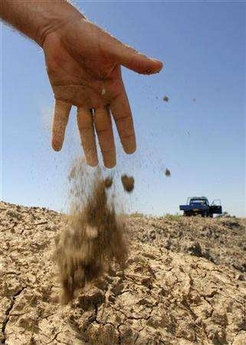Human skin hosts zoo of bacteria
(Reuters)Updated: 2007-02-06 10:54
WASHINGTON - Researchers on a safari for microbes have found that human skin is populated by a veritable menagerie of bacteria - 182 species - some apparently living there permanently and others just dropping by for a visit.
 A farmer drops some dry soil on his property in Australia February 2, 2007.[Reuters]  |
In research published on Monday in the Proceedings of the National Academy of Sciences, Blaser and his colleagues took swabs from the forearms of six healthy people to study the bacterial populations in human skin - our largest organ.
"We identify about 182 species," Blaser said in an interview. "And based on those numbers, we estimate there are probably at least 250 species in the skin."
"In comparison," Blaser added, "a good zoo might have 100 species or 200 species. So we already know that there are as many different species in our skin, just on the forearm, as there are in a good zoo."
Bacteria are single-celled micro-organisms believed to have been the first living things on Earth. While some cause disease, bacteria also reside normally in our bodies, for example in the digestive tract, performing useful chores.
"Without good bacteria, the body could not survive," added Dr. Zhan Gao, a scientist in Blaser's lab involved in the study.
The researchers noted that microbes in the body actually outnumber human cells 10-to-1.
"Our microbes are actually, in essence, a part of our body," Blaser said.
"We think that many of the normal organisms are protecting the skin. So that's why I don't think it's a great idea to keep washing all the time because we're basically washing off one of our defence layers," Blaser added.
It has long been known that bacteria reside in the skin, but Blaser and his colleagues used a sophisticated molecular technique based on DNA to conduct a rigorous census.
The inhabitants proved to be more diverse than had been thought, with about 8 percent of the species previously unknown, the researchers found.
Some bacteria seemed to be permanent residents of the skin, with four genera - Staphylococcus, Streptococcus, Propionibacteria and Corynebacteria - accounting for a bit more than half the population. Others were more transient.
In each person, the population of bacteria changed over time although a core set existed for each.
The volunteers included three men and three women, and the findings suggested the two sexes may differ in the bacteria they tote along.
The researchers previously had studied bacteria in the stomach and oesophagus. With this research, they found that the insides of the body and the skin had major differences in bacterial populations.
"Microbes have been living in animals probably for a billion years. And the microbes that we have in our body are not accidental. They have evolved with us," Blaser said.
|
||
|
||
|
|